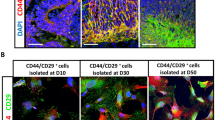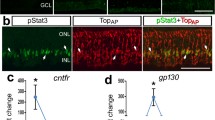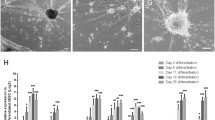Abstract
Neurospheres prepared from multipotent progenitors in the retina obtained from postnatal mice differentiate into neurons and Müller glia (De Melo Reis et al., in Cell Mol Neurobiol 31:835–846, 2011). Here, we investigated whether neurospheres prepared from adult chickens (ciliary marginal zone, CMZ) or (ciliary body) retina could also lead to differentiated neurons and glia. Neurospheres were prepared from post-hatched chickens or from adult mice after 7 days in the presence of mitogenic factors (FGFb, insulin, and EGF), generating neurons and glial cells. In addition, Müller (2M6 or glutamine synthetase positive cells) derived from post-hatch chicken CMZ neurospheres displayed the dopaminergic phenotype. Furthermore, we observed that Müller cells derived from adult chickens and mice retina neurospheres released significant amounts of dopamine as well as of its metabolites. Taken together, our data lead us to conclude that as for embryonic (chick) or newborn (mouse), the dopaminergic phenotype is a default condition of Müller glial cells obtained from neurospheres prepared from mature retina. Our data raise the possibility that Müller cells from differentiated tissue could be used to ameliorate neurodegenerative diseases involving dopaminergic dysfunction as in Parkinson’s disease as shown previously (Stutz et al., in J Neurochem 128:829–840, 2014).





Similar content being viewed by others
References
Ahmad I, Tang L, Pham H (2000) Identification of neural progenitors in the adult mammalian eye. Biochem Biophys Res Commun 270:517–521. https://doi.org/10.1006/bbrc.2000.2473
Alunni A, Bally-Cuif L (2016) A comparative view of regenerative neurogenesis in vertebrates. Development 143:741–753. https://doi.org/10.1242/dev.122796
Beckman D, Santos LE, Americo TA, Ledo JH, de Mello FG, Linden R (2016) Reply to altered monoaminergic systems and depressive-like behavior in congenic prion protein knock-out mice. J Biol Chem 290:26351. https://doi.org/10.1074/jbc.L115.689232
Belecky-Adams T, Tomarev S, Li HS, Ploder L, McInnes RR, Sundin O, Adler R (1997) Pax-6, Prox 1, and Chx10 homeobox gene expression correlates with phenotypic fate of retinal precursor cells. Invest Ophthalmol Vis Sci 38:1293–1303
Bhattacharya S, Dooley C, Soto F, Madson J, Das AV, Ahmad I (2004) Involvement of Ath3 in CNTF-mediated differentiation of the late retinal progenitors. Mol Cell Neurosci 27:32–43. https://doi.org/10.1016/j.mcn.2004.05.004
Bringmann A et al (2006) Muller cells in the healthy and diseased retina. Prog Retin Eye Res 25:397–424. https://doi.org/10.1016/j.preteyeres.2006.05.003
Chen X, Thomson H, Cooke J, Scott J, Hossain P, Lotery A (2014) Adult limbal neurosphere cells: a potential autologous cell resource for retinal cell generation. PLoS ONE 9:e108418. https://doi.org/10.1371/journal.pone.0108418
Coles BL et al (2004) Facile isolation and the characterization of human retinal stem cells. Proc Natl Acad Sci USA 101:15772–15777. https://doi.org/10.1073/pnas.0401596101
De Melo Reis RA et al (2011) Functional identification of cell phenotypes differentiating from mice retinal neurospheres using single cell calcium imaging. Cell Mol Neurobiol 31:835–846. https://doi.org/10.1007/s10571-011-9673-6
Deleyrolle LP, Reynolds BA (2009) Isolation, expansion, and differentiation of adult mammalian neural stem and progenitor cells using the neurosphere assay. Methods Mol Biol 549:91–101. https://doi.org/10.1007/978-1-60327-931-4_7
Dunkley PR, Bobrovskaya L, Graham ME, von Nagy-Felsobuki EI, Dickson PW (2004) Tyrosine hydroxylase phosphorylation: regulation and consequences. J Neurochem 91:1025–1043. https://doi.org/10.1111/j.1471-4159.2004.02797.x
Fischer AJ, Reh TA (2000) Identification of a proliferating marginal zone of retinal progenitors in postnatal chickens. Dev Biol 220:197–210. https://doi.org/10.1006/dbio.2000.9640
Fischer AJ, Reh TA (2001) Muller glia are a potential source of neural regeneration in the postnatal chicken retina. Nat Neurosci 4:247–252. https://doi.org/10.1038/85090
Fischer AJ, Hendrickson A, Reh TA (2001) Immunocytochemical characterization of cysts in the peripheral retina and pars plana of the adult primate. Invest Ophthalmol Vis Sci 42:3256–3263
Goldman D (2014) Muller glial cell reprogramming and retina regeneration. Nat Rev Neurosci 15:431–442. https://doi.org/10.1038/nrn3723
Hollyfield JG (1968) Differential addition of cells to the retina in Rana pipiens tadpoles. Dev Biol 18:163–179
Karl MO, Hayes S, Nelson BR, Tan K, Buckingham B, Reh TA (2008) Stimulation of neural regeneration in the mouse retina. Proc Natl Acad Sci USA 105:19508–19513. https://doi.org/10.1073/pnas.0807453105
Kubota R, Hokoc JN, Moshiri A, McGuire C, Reh TA (2002) A comparative study of neurogenesis in the retinal ciliary marginal zone of homeothermic vertebrates. Brain Res Dev Brain Res 134:31–41
Kubrusly RC et al (2005) Expression of functional receptors and transmitter enzymes in cultured Muller cells. Brain Res 1038:141–149. https://doi.org/10.1016/j.brainres.2005.01.031
Kubrusly RC et al (2008) Expression of functional dopaminergic phenotype in purified cultured Muller cells from vertebrate retina. Neurochem Int 53:63–70. https://doi.org/10.1016/j.neuint.2008.05.002
Lamba DA, Karl MO, Reh TA (2009) Strategies for retinal repair: cell replacement and regeneration. Prog Brain Res 175:23–31. https://doi.org/10.1016/s0079-6123(09)17502-7
Morris VB, Wylie CC, Miles VJ (1976) The growth of the chick retina after hatching. Anat Rec 184:111–113. https://doi.org/10.1002/ar.1091840109
Moshiri A, Reh TA (2004) Persistent progenitors at the retinal margin of ptc+/− mice. J Neurosci 24:229–237. https://doi.org/10.1523/jneurosci.2980-03.2004
Ooto S, Akagi T, Kageyama R, Akita J, Mandai M, Honda Y, Takahashi M (2004) Potential for neural regeneration after neurotoxic injury in the adult mammalian retina. Proc Natl Acad Sci USA 101:13654–13659. https://doi.org/10.1073/pnas.0402129101
Raymond PA, Hitchcock PF (1997) Retinal regeneration: common principles but a diversity of mechanisms. Adv Neurol 72:171–184
Reh TA (1987) Cell-specific regulation of neuronal production in the larval frog retina. J Neurosci 7:3317–3324
Reis R, da Silva M, dos Santos N, Bampton E, Taylor J, de Mello F, Linden R (2002) Sympathetic neuronal survival induced by retinal trophic factors. J Neurobiol 50:13–23. https://doi.org/10.1002/neu.10008
Reynolds BA, Weiss S (1992) Generation of neurons and astrocytes from isolated cells of the adult mammalian central nervous system. Science 255:1707–1710
Stutz B et al (2014) Murine dopaminergic Muller cells restore motor function in a model of Parkinson’s disease. J Neurochem 128:829–840. https://doi.org/10.1111/jnc.12475
Turner DL, Cepko CL (1987) A common progenitor for neurons and glia persists in rat retina late in development. Nature 328:131–136. https://doi.org/10.1038/328131a0
Acknowledgements
Grants from Fundação de Amparo à Pesquisa do Estado do Rio de Janeiro (FAPERJ), Conselho Nacional de Desenvolvimento Científico e Tecnológico (CNPq), Instituto Nacional de Ciência e Tecnologia de Neurociência Translacional (INCT-INNT) and Coordenação de Aperfeiçoamento de Pessoal de Nível Superior (CAPES) supported this work. We are indebted to the technical support of Luciano C. Ferreira and AurizeteBezerra.
Author information
Authors and Affiliations
Contributions
BSR: Performed cell culturing, fluorescent imaging, statistical analysis and manuscript writing. LES: Performed biochemistry assays of western blotting, HPLC, quantitative analysis as well as manuscript writing. RAMR: Performed cell culturing, interpretation of results, and writing of manuscript. FGM: interpretation of results, writing of manuscript and the supervision of the project. VTRR: contributed to the general administration, fluorescence imaging, interpretation of results, development, and writing of the manuscript.
Corresponding author
Ethics declarations
Conflict of interest
The authors declare no conflict of interests.
Rights and permissions
About this article
Cite this article
da Silva, B.R., Santos, L.E., de Melo Reis, R.A. et al. Müller Cells Derived from Adult Chicken and Mouse Retina Neurospheres Acquire the Dopaminergic Phenotype. Cell Mol Neurobiol 39, 99–109 (2019). https://doi.org/10.1007/s10571-018-0636-z
Received:
Accepted:
Published:
Issue Date:
DOI: https://doi.org/10.1007/s10571-018-0636-z




